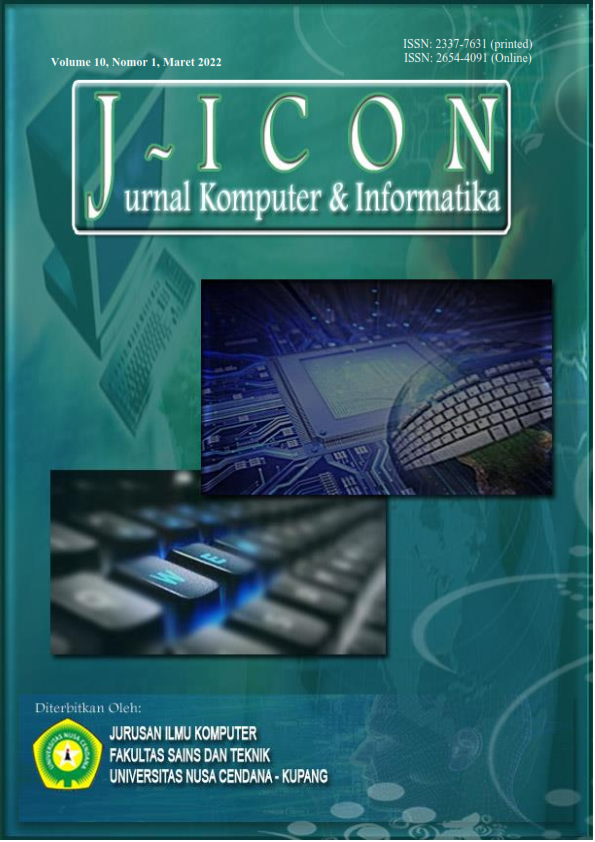Quality Analysis of UNAI Module on User Satisfaction with WebQual 4.0 and Importance Performance Analysis (IPA)
Abstract
In the current digital era, technology is developing very rapidly where the role of internet technology is increasingly influential because all activities can be carried out on the internet. Many universities use the website as an information medium to provide the information needed for students in their academic needs. The purpose of this study was to measure the level of quality of the academic information system at the Adventist University of Indonesia (UNAI) at the level of quality of use using the WebQual 4.0 approach. WebQual is a framework with techniques for measuring website quality by compiling user perceptions based on four existing dimensions, namely usability, information quality, services interaction quality and overall impression. The population in this study were students at UNAI who used the unai module. Samples were taken as many as 94 respondents. This research was conducted using a WebQual 4.0 dimension approach by distributing to respondents based on four WebQual 4.0 dimensions and conducting an analysis with importance performance analysis (IPA) with the aim of getting the level of user satisfaction then the results of the analysis of the academic information system at UNAI are still not suitable for user satisfaction where there are 4 items in the A quadrant, namely items U5, IntQ19, Int21, and OI22. Suggestions that can be given to website owners are to be able to add chat forum features, chat boxes and live chat.
Downloads
References
J. Sinuraya, “Pengukuran Kualitas Website Dengan Metode WebQual 4.0 (Studi Kasus Website Politeknik Negeri Medan),” Jurnal Teknik Dan Inovasi, vol. 6, no. 2, pp. 51–59, 2019.
T. Hidayat and M. Muttaqin, “Pengujian sistem informasi pendaftaran dan pembayaran wisuda online menggunakan black box testing dengan metode equivalence partitioning dan boundary value analysis,” Jurnal Teknik Informatika UNIS (JUTIS), vol. 6, no. 1, pp. 25–29, 2018, doi: 10.33592/jutis.Vol6.Iss1.38.
W. S. Fatmala and A. R. Suprapto, “Analisis kualitas layanan website e-commerce berrybenka terhadap kepuasan pengunjung menggunakan metode WebQual 4.0 dan importance performance analysis (IPA),” Jurnal Pengembangan Teknologi Informasi dan Ilmu Komputer, vol. 2, no. 175–183, p. 964, 2018.
R. Pamungkas and S. Saifullah, “Evaluasi Kualitas Website Program Studi Sistem Informasi Universitas PGRI Madiun Menggunakan Webqual 4.0,” INTENSIF: Jurnal Ilmiah Penelitian Dan Penerapan Teknologi Sistem Informasi, vol. 3, no. 1, pp. 22–31, 2019, doi: 10.29407/intensif.v3i1.12137.
W. Sastika, “Analisis Kualitas Layanan dengan Menggunakan E-service Quality untuk Mengetahui Kepuasan Pelanggan Belanja Online Shoppe (Studi Kasus: Pelanggan Shopee di Kota Bandung 2017),” IKRA-ITH HUMANIORA: Jurnal Sosial dan Humaniora, vol. 2, no. 2, pp. 69–74, 2018.
E. E. Barus, Suprapto, and A. D. Herlambang, “Analisis Kualitas Website Tribunnews. com Menggunakan Metode Webqual dan Importance Performance Analysis,” Jurnal Pengembangan Teknologi Informasi dan Ilmu Komputer, vol. 2, no. 4, pp. 1483–1491, 2018.
A. Manik, I. Salamah, and E. Susanti, “Pengaruh Metode Webqual 4.0 Terhadap Kepuasan Pengguna Website Politeknik Negeri Sriwijaya,” Jurnal Elektro dan Telekomunikasi Terapan, vol. 4, no. 1, pp. 477–477, 2017, doi: 10.25124/jett.v4i1.994.
R. K. D. Siregar and R. A. Fitriawan, “Analisis Kualitas Website Ruangguru.com Menggunakan Metode Webqual 4.0 Dan Ipa (importance Performance Analysis),” eProceedings of Management, vol. 5, no. 1, pp. 1201–1208, 2018.
A. Hafiz, “Mengukur Kualitas Website dengan Pendekatan Webqual 4.0 Modifikasi,” in Prosiding Seminar Nasional Darmajaya, Lampung, 2017, vol. 1, no. 1, pp. 443–457.
F. Yusup, “Uji validitas dan reliabilitas instrumen penelitian kuantitatif,” Tarbiyah: Jurnal Ilmiah Kependidikan, vol. 7, no. 1, pp. 17–23, 2018, doi: 10.18592/tarbiyah.v7i1.2100.
S. S. Harahap, “Hubungan usia, tingkat pendidikan, kemampuan bekerja dan masa bekerja terhadap kinerja pegawai dengan menggunakan metode Pearson Correlation,” Jurnal Teknovasi, vol. 6, no. 2, pp. 12–26, 2019.
S. Ayu and M. S. B. Rosli, “Uji Reliabilitas Instrumen Penggunaan SPADA (Sistem Pembelajaran dalam Jaringan),” Biormatika: Jurnal ilmiah fakultas keguruan dan ilmu pendidikan, vol. 6, no. 1, pp. 145–155, 2020, doi: 10.35569/biormatika.v6i1.706.
L. A. Utami, A. Gani, and S. Suparni, “Penerapan Metode Webqual 4.0 dan IPA Dalam Mengukur Kualitas Website VISLOG PT. Citra Surya Indonesia,” Komputika: Jurnal Sistem Komputer, vol. 9, no. 1, pp. 25–34, 2020.
W. B. D. Hasna and I. K. D. Nuryana, “Analisis Kualitas Layanan Website Sociolla terhadap Kepuasan Pelanggan dengan Metode WebQual 4.0 dan Importance Performance Analysis (IPA),” Journal of Emerging Information System and Business Intelligence (JEISBI), vol. 2, no. 4, pp. 27–32, 2021.
S. Syukhri, “Analisis Kepuasan Mahasiswa Terhadap Pelayanan Laboratorium Jaringan Menggunakan Pendekatan Importance-Performance Analysis,” INVOTEK: Jurnal Inovasi Vokasional dan Teknologi, vol. 18, no. 2, pp. 109–114, 2018, doi: 10.24036/invotek.v18i2.417.
Copyright (c) 2022 Gabriel Putra Advent Yakop Sihombing, Jay Idoan Sihotang

This work is licensed under a Creative Commons Attribution 4.0 International License.
The author submitting the manuscript must understand and agree that if accepted for publication, authors retain copyright and grant the journal right of first publication with the work simultaneously licensed under a Creative Commons Attribution (CC-BY) 4.0 License that allows others to share the work with an acknowledgment of the work’s authorship and initial publication in this journal.
 Gabriel Putra Advent Yakop Sihombing(1*)
Gabriel Putra Advent Yakop Sihombing(1*)




